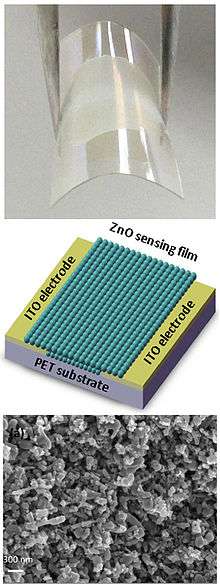Zinc oxide nanorod sensor

Flexible gas sensor based on ZnO nanorods and its internal structure. ITO stands for indium tin oxide and PET for polyethylene terephthalate.[1]
A zinc oxide nanorod sensor or ZnO nanorod sensor is an electronic or optical device detecting presence of certain gas or liquid molecules (e.g. humidity,[2] NO, hydrogen,[3][4] etc.) in the ambient atmosphere. The sensor exploits enhanced surface area (and thus surface activity) intrinsic to all nano-sized materials, including ZnO nanorods. Adsorption of molecules on the nanorods can be detected through variation of the nanorods' properties, such as photoluminescence, electrical conductivity, vibration frequency, mass, etc. The simplest and thus most popular way is to pass electrical current through the nanorods and observe its changes upon gas exposure.
See also
References
- ↑ Zheng, Z. Q.; Yao, J. D.; Wang, B.; Yang, G. W. (2015). "Light-controlling, flexible and transparent ethanol gas sensor based on ZnO nanoparticles for wearable devices". Scientific Reports. 5: 11070. doi:10.1038/srep11070. PMC 4468465
 . PMID 26076705.
. PMID 26076705. - ↑ Majithia, R.; Ritter, S.; Meissner, K.E. (February 2014). "Heterogeneous nucleation for synthesis of sub-20nm ZnO nanopods and their application to optical humidity sensing". Analytica Chimica Acta. 812: 206–214. doi:10.1016/j.aca.2014.01.012. PMID 24491783.
- ↑ Pearton, S. J. et al. (2005) Highly stable and reliable lightweight hydrogen sensors for fuel cells. Florida Solar Energy Center
- ↑ Lin, J. et al. (2015) GaN-based and ZnO nanorod sensors for wireless hydrogen leak detection. International symposium on processes at the compound-semiconductor/solution interface, Quebec PQ , Canada
Reviews
- J. G. Lu et al. "Quasi-one-dimensional metal oxide materials—Synthesis, properties and applications" (42 pages) Mater. Sci. Eng. R 52 (2006) 49
- S.J. Pearton et al. "ZnO-based nanowires" Nano 4 (2007) 201
- W. Park et al. "Catalyst-free growth of ZnO nanorods and their nanodevice applications" Int. J. Nanotechnology 3 (2006) 372
External links
This article is issued from Wikipedia - version of the 10/24/2016. The text is available under the Creative Commons Attribution/Share Alike but additional terms may apply for the media files.